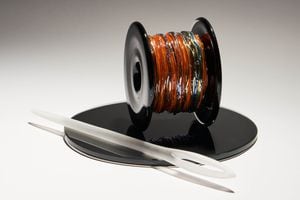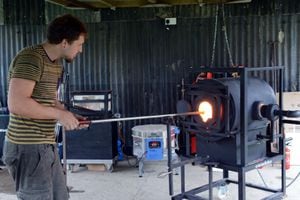How master glass blower Elliot Walker has turned traditional skill into modern art
Enjoying 15 minutes of fame was never part of the plan for Elliot Walker.

He grew up in Codsall, near the border between Wolverhampton and Shropshire. He studied psychology at university, fancying a career as a nine-to-five professional. Then life got in the way and he took a different path, little realising where it would lead.
The 32-year-old found himself bored by that, however. Who wants to sit in an office and wear a suit when you can look like a youthful version of Clint Mansell and lead a rock’n’roll lifestyle? Besides, Elliot wanted to find an outlet for his creativity. An artful soul, he needed to find expression for what lay within. You’d have thought a guitar would do it, or perhaps an easel, some brushes and some oils. But no. He embarked on a fabulously absurd course of action, opting for one of the most difficult, dangerous and downright ridiculous creative pursuits on the planet: glass blowing.
Hailing from the Black Country - well, nearly - gave him an edge, of course. The region is synonymous with blown glass, or, rather, it was until all the glassworks closed down and highly skilled craftsmen got jobs driving vans for Amazon. But Elliot was determined. For sure, furnaces and reheating chambers don’t come cheaply, but he stuck at it.
“I really had a moment when I was in the second year of university,” he says. “I just decided to follow a different path.” More than a decade on, he’s still walking along it.
He’d started working with glass some years earlier, while at sixth form, in Codsall. There was an evening class in stained glass and he thought it would be fun. It was. That latent interest blossomed when he got to university. “I moved into the halls of residence and took my own grinder. I was grinding away, smashing up bits of glass and making panels.”
Elliot did a few commissions, making work for local craft shows while researching how glass was made and exploring the careers of various glass blowing artists.
“I’ve always been doing something. I always had an outlet for my creativity. When I found glass, that just hooked me in.”

So he wrapped up his degree at Bangor, which was odd as he’d already decided he didn’t want a career in anything to do with psychology. Then he applied to study in Dudley. He also applied to the International Glass Centre, which closed the year he applied and was relocated to the Dudley College campus. “I loved it,” he says. “There was no one there, really, there was hardly anyone on the course so I had free reign.”
That freedom allowed him to flourish. He gravitated to glass sculpture and found an ally in Professor Keith Cummings, from Heart of England Glass. Prof Cummings had been working with glass for around 50 years, during which time both he and the industry had changed enormously.
Another mentor helped to set him on his way. At Dudley College, while studying casting, fusing and enamelling, he met Tim Boswell, an award-winning glass artist who built his notoriety over a decade in and around the famous historic glass quarter of Stourbridge. An unconventional approach to the ancient glass-blowing craft had given Tim’s work a distinctive and unique style creating pieces rich in colour influenced by psychedelia and op-art patterns. Combining complex hot glass and glass fusing techniques requires a number of specialist skills and hours of intense concentration and dexterity. He knew all about that and proved to be the perfect person from whom Elliot could learn.
“Professor Cummings was really important. Then I met Tim, who’s my longest-lasting colleague. He got me into the furnace room and I started rolling the irons. As anyone will tell you, it’s really addictive once you get into it.”
Glass is unique. Artists view it as a living material that’s mouldable and has really interesting properties. “I love the transparency of it and the vibrancy of colour. It’s such a common material but when you work with it as an artist it becomes quite alien.”
Aliens aren’t easy to work with, of course, and Elliot suffered numerous setbacks as he tried to tame a 1,000C (1,832F) product. “I fell into hot glass but realised it’s unforgiving and difficult to master. The whole thing is pretty painful at times. But it’s also remarkable because you can see the sculpture appearing right in front of you. You can do that in ceramics, but there are firing processes that last weeks or months with glass. In glass, you can see it almost immediately. It’s designed for the impatient artist. I love the immediacy.”

And so the kid who grew up making things out of wood or painting in his room set sail on his new creative voyage. After a year at Dudley, he signed up for an MA course in applied arts at Wolverhampton, where he focused on glass. “I did that for three years. Then I moved to London Glassblowing. I’d been picked up, or spotted, when I was doing demonstrations around the country.”
His mentor at London Glassblowing was Peter Layton, a giant of the industry who’s always taken inspiration from his environment, natural or manmade: a stone wall on a snowy day, the London skyline, or works by great painters. From a mere detail, a flash of a Klimt orange or a slick of oil on the Thames, Peter has created painterly works with a masterly use of colour. Throughout his career, he has been courted by major art institutions, commercial buyers and private collectors. His work is held in various museums in the UK, Europe and America, including the Victoria and Albert Museum, London and the Fitzwilliam Museum, Cambridge, UK.
“Peter offered me the job. It all went from there.”
Elliot spent eight years at London Glassblowing, with his role developing rapidly. He mixed that with some work for a company in the Midlands, making beautiful chandeliers.
He says: “I create a whole variety of glass sculptures. It started off being inspired by classic sculpture, so I was doing figurative work. That morphed into still life work, still life sculptures with glass, tableware and cut-glass fruit. There’s a lot of pattern and colour.”

He exhibits at galleries and his partner, Bethany, created an online gallery called Blowfish Glass Art, during the pandemic. “She’s been selling a big variety of work. We’re bringing out pieces every few months. I work with galleries around the UK. I’m doing a show with Blowfish in Belgium later this year. The work goes from £500 up to £25,000. Within that, there’s a lot of scope and it depends what I’m working on. I rarely work to commission. I’ve done a few recently that I’ve really enjoyed. I like to hear people’s ideas. But unless it sits in a realm that I’m involved in, I tend not to.”
We mentioned 15 minutes of fame. They came to Elliot when he was asked to appear in Blown Away 2, on Netflix.
“I had to apply to Netflix. I was reluctant to do that. I didn’t watch the first series until I did my application. I had to work out how the hell to get through the difficult process. It couldn’t have been more challenging. My partner elbowed me into applying and I thought I’d failed the interview. We were so busy in the time. We had a huge lighting commission. We’d just set up a show. I had my new furnace being delivered.”
Happily, Elliot didn’t mess up the interview. Instead, he was asked to feature on the show and commit to being away for seven weeks. “As soon as I got there it was great. It was eye-opning to me to meet people from all over the place, especially makers from the USA where the scene is much better. Without having been there before, the thing that struck me about talking to the American artists was how many amazing, funded institutions there are for making.
“We don’t have a contemporary museum for glass here. We only have one museum for glass. Also, in terms of funding, if an artist has an idea, it’s difficult to get funding. The contrast between the UK and USA couldn’t be greater. The support and education to develop new artists in the States is incredible.
“I guess I understand why it’s less well supported here because it’s so difficult. It is last on the list in terms of material creativity because it takes so long to learn and the barriers are so high. To make a simple wine glass you need a furnace, a reheating chamber and the tools. It’s prohibitive to someone starting up in their garden. It’s not a hobby for the masses and the institutions aren’t really there to support.”
Yet that didn’t deter Elliot and there’s a sense of pride that he’s continuing a tradition for which this area is celebrated. For centuries glass has been manufactured in the Stourbridge area, reputedly started in the 17th century by French glassmakers from the Lorraine region. They were attracted to the area by the rich natural resources of coal and fireclay for lining furnaces, making it the perfect location for the industry. Stourbridge Glass is recognised as amongst the finest in the world and has been used countless times as gifts for royalty and visiting dignitaries to the UK.
“The industry’s story is one of decline and renaissance. All the old Stuart Crystal factories and the Tudor Glass Factory are now museums. The idea of apprenticeships is really finished as far as I’m concerned. But that knowledge and skill set is still around. You have to know who you are talking to in the pub to get anything out of it. People in my peer group or slightly older are working with the same techniques to create something new. Sculpture and art is my focus. There’s a lot of people working in a much smaller set up to the way things used to be.”
Creating new works is a challenge. When Elliot works on projects, he can be sure that something will go wrong. He laughs. “Yes, it goes wrong daily. Glass blowing has been dubbed the art of salvage by a prominent American maker. I see it in the way other people might see performing a piece of music. You have your music and composition. You have a concert and when you turn up you only have one shot to do it well. If it goes wrong you have to salvage or start again. it’s demanding physically. You have to have balance and grace. It’s not the exclusive realm of the butch male, there’s a whole other skillset.”
For Elliot, new works start on paper. A lot of my work is iterative. One idea blends and breeds another. He can draw and sketch and plan as much as he likes but until he’s in the studio he doesn’t know whether the glass will agree. “A lot of times it’s a process of convincing or tricking the glass to do what you want. Your idea is curtailed and altered and informed by the way the material moves. You only know if you are getting anywhere when you are sketching it out in the glass itself. Creating a finished piece takes months of colour testing, or you can get a piece done in a matter of hours with the right attitude, the right environment and a lot of luck. There are moments when you don’t have to try hard. it’s like a gambling addiction. You’re always after that perfect win. The failures increase your need to get the win.”
Most recently, he’s raised money for the Healthcare Workers’ Foundation by creating two pieces, titled The Threads Connecting Us, which measure approximately 40cm in height and 15cm in width. Fifty per cent of the funds raised from their sale at auction will be donated to the charity. They each come with a separate needle.
“I was pleased to have the NHS request. The whole concept of this piece was bought about by public request. London Glassblowing put out the request and loads of ideas came in. The one that worked was about collective endeavour. It was great to make something inspired by that. The NHS has been a huge part of our recovery. The politics aside, the NHS is the most important thing during the pandemic and that’s how we’re getting out of it.”
Like many from the Black Country, Elliot is a homebird at heart and after setting up his own studio in Hertford and working there and in London, he’s soon to return. He’s moving his studio to Stourbridge, to the Lighthouse. “It’s the last glass cone in the UK. It’s the most complete site in the world, the best preserved in the world. The cone is such a beautiful building. We’ll be setting up studio on that site as Blowfish Glass. That’ll be open to the public. We’re excited to get back to the Midlands. We’re hoping to add to the revival of the area and the interest in it.”
Preserving traditional skills, but taking them into the modern idiom, Elliot is in a glass of his own.





